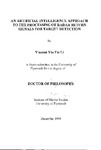AN ARTIFICIAL INTELLIGENCE APPROACH TO THE PROCESSING OF RADAR RETURN SIGNALS FOR TARGET DETECTION
| dc.contributor.author | Li, Vincent Yiu Fai | |
| dc.contributor.other | Faculty of Science and Engineering | en_US |
| dc.date.accessioned | 2013-11-21T14:33:52Z | |
| dc.date.available | 2013-11-21T14:33:52Z | |
| dc.date.issued | 1999 | |
| dc.identifier | NOT AVAILABLE | en_US |
| dc.identifier.uri | http://hdl.handle.net/10026.1/2814 | |
| dc.description.abstract |
Most of the operating vessel traffic management systems experience problems, such as track loss and track swap, which may cause confusion to the traffic regulators and lead to potential hazards in the harbour operation. The reason is mainly due to the limited adaptive capabilities of the algorithms used in the detection process. The decision on whether a target is present is usually based on the magnitude of the returning echoes. Such a method has a low efficiency in discriminating between the target and clutter, especially when the signal to noise ratio is low. The performance of radar target detection depends on the features, which can be used to discriminate between clutter and targets. To have a significant improvement in the detection of weak targets, more obvious discriminating features must be identified and extracted. This research investigates conventional Constant False Alarm Rate (CFAR) algorithms and introduces the approach of applying ar1ificial intelligence methods to the target detection problems. Previous research has been unde11aken to improve the detection capability of the radar system in the heavy clutter environment and many new CFAR algorithms, which are based on amplitude information only, have been developed. This research studies these algorithms and proposes that it is feasible to design and develop an advanced target detection system that is capable of discriminating targets from clutters by learning the .different features extracted from radar returns. The approach adopted for this further work into target detection was the use of neural networks. Results presented show that such a network is able to learn particular features of specific radar return signals, e.g. rain clutter, sea clutter, target, and to decide if a target is present in a finite window of data. The work includes a study of the characteristics of radar signals and identification of the features that can be used in the process of effective detection. The use of a general purpose marine radar has allowed the collection of live signals from the Plymouth harbour for analysis, training and validation. The approach of using data from the real environment has enabled the developed detection system to be exposed to real clutter conditions that cannot be obtained when using simulated data. The performance of the neural network detection system is evaluated with further recorded data and the results obtained are compared with the conventional CFAR algorithms. It is shown that the neural system can learn the features of specific radar signals and provide a superior performance in detecting targets from clutters. Areas for further research and development arc presented; these include the use of a sophisticated recording system, high speed processors and the potential for target classification. | en_US |
| dc.language.iso | en | en_US |
| dc.publisher | University of Plymouth | en_US |
| dc.title | AN ARTIFICIAL INTELLIGENCE APPROACH TO THE PROCESSING OF RADAR RETURN SIGNALS FOR TARGET DETECTION | en_US |
| dc.type | Thesis | |
| plymouth.version | Full version | en_US |
| dc.identifier.doi | http://dx.doi.org/10.24382/4596 |
Files in this item
This item appears in the following Collection(s)
-
01 Research Theses Main Collection
Research Theses Main


